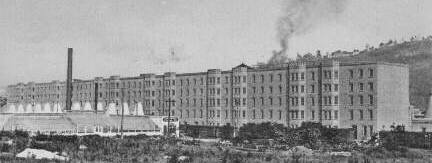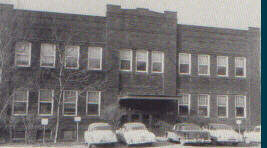 In August 1905, surveyors had begun laying the foundation lines for the mammoth Homer Laughlin Co. pottery along the river-front site. The million dollar structure - 664 feet long and 300 feet wide -- had 30 kilns - 13 biscuit and 17 gloss - besides 24 decorating kilns.
By 1907 Homer Laughlin Plant No. 4 was finished and had gone into production -- the biggest pottery in the world - and the firm's offices were moved across the river.
In 1913, a 15-kiln pottery structure, Plant No. 5, was built linking the original giant pottery and that same year the Edwin M. Knowles Co. which had a 6-kiln pottery at Chester, built a new 15-kiln pottery at Newell.[1] In August 1905, surveyors had begun laying the foundation lines for the mammoth Homer Laughlin Co. pottery along the river-front site. The million dollar structure - 664 feet long and 300 feet wide -- had 30 kilns - 13 biscuit and 17 gloss - besides 24 decorating kilns.
By 1907 Homer Laughlin Plant No. 4 was finished and had gone into production -- the biggest pottery in the world - and the firm's offices were moved across the river.
In 1913, a 15-kiln pottery structure, Plant No. 5, was built linking the original giant pottery and that same year the Edwin M. Knowles Co. which had a 6-kiln pottery at Chester, built a new 15-kiln pottery at Newell.[1]
These plants, although the most modern of their type, used the upright beehive kiln. In 1923 however, Laughlin built plant No. 6 - a revolutionary pottery construction in that it employed a tunnel kiln for the entire manufacture process - a capacity of 15 ordinary kilns.[2]
Although the new plant was quite a gamble for the firm, within six months it had proven successful and was turning out ware of a better grade than possible with the older upright kilns in which the heat distribution was unequal.
A new decorating kiln was built after construction of Plant 6, and automatic gas-fired kiln which also proved a success after some modification. Completion was delayed when an engineer unfamiliar with the properties of natural gas, let the feed valve on for some time before igniting the gas, and the explosion settled the roof of the kiln.
In 1926, Plant No 7. - a duplicate of Plant No. 5 - was constructed to meet the expanding market for dinnerware. The remaining plants in East End [3], still using upright kilns, were found to be outmoded and they were abandoned in 1929, and another large structure, Plant No 8 raised at Newell.
Between 1924 and 1927 the company had changed over its Plants 4 and 5, replacing the upright kilns with tunnel kilns. Further mechanization featured the expanding pottery including spray glazing of flatware, conveyer belts, automatic jiggering and automatic cup-forming. Lining machines and stamping machines took over some of the duties of the longtime craftsmen.
Employment at the large pottery rose at times as high as 3,200 but on the average the working force is closer to 2,300.
The growth of the Laughlin firm to a ranking leader in the pottery took place under the direction of William E. Wells, secretary, treasurer and general manager, and Marcus Aaron, president. Wells began to work for Homer Laughlin in 1889, coming to East Liverpool from Steubenville.
Wells and Aaron took over the leadership of the pottery when Laughlin incorporated the firm and sold his holdings to the Aaron syndicate. for more than 40 year, Wells was an active leader in the policies not only of the Laughlin firm, but of the general pottery industry in America.
In January 1930, he retired, being succeeded by his son, Joseph M. Wells, and Aaron became chairman of the board. His son M.L. Aaron became president.[4] W. E. Wells died in 1931.
 The Edwin M. Knowles Co. plant has continued to utilize modern production techniques since the firm moved from Chester in 1913, and today ranks not only second in dinnerware production in Newell but second in the pottery field.
Implemented by automatic jiggering machines, new type decorating kilns and a new addition prior to World War II, along with new gloss kilns and rebuilt bisque kilns and conveyor systems since the war, the firm is possibly the most mechanized plant in the industry.[5] The Edwin M. Knowles Co. plant has continued to utilize modern production techniques since the firm moved from Chester in 1913, and today ranks not only second in dinnerware production in Newell but second in the pottery field.
Implemented by automatic jiggering machines, new type decorating kilns and a new addition prior to World War II, along with new gloss kilns and rebuilt bisque kilns and conveyor systems since the war, the firm is possibly the most mechanized plant in the industry.[5]
1 Harker Pottery took over the Chester plant when Knowles left. The plant was destroyed by fire in 1975.
2 At one time there were dozens of upright (bottle) kilns between Chester, Newell, and East Liverpool. Today there are three; one in Wellsville, one towards the river in East Liverpool, and one at Hall China.
3 The East End plants were numbers 1, 2, and 3.
4 In 2002, The Wells family has purchased the interests of the other stockholders and are now the sole owners.
5 The Edwin M. Knowles China Co. closed in 1963.
|